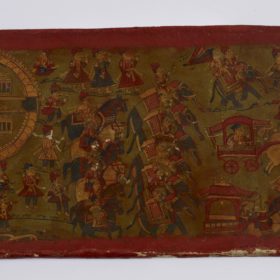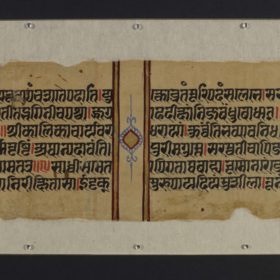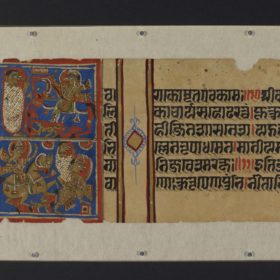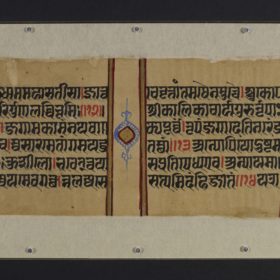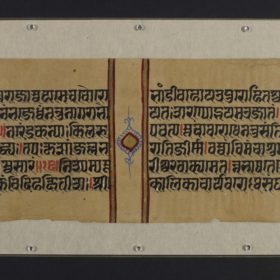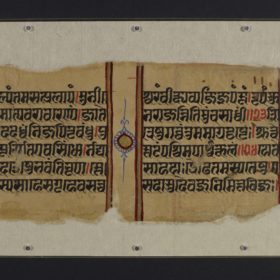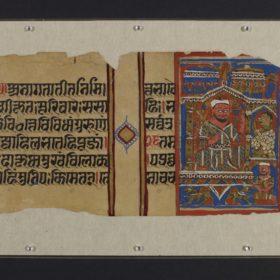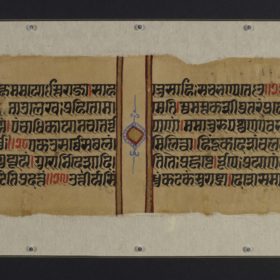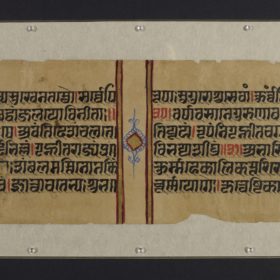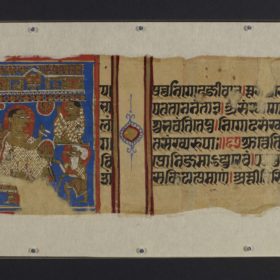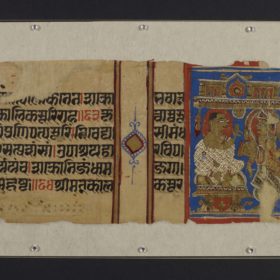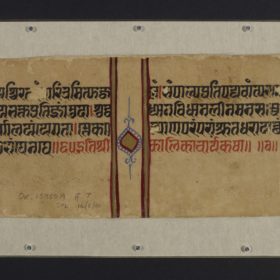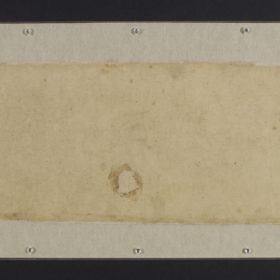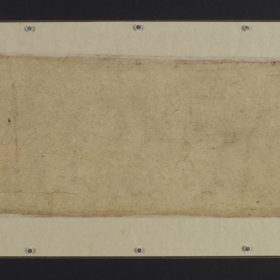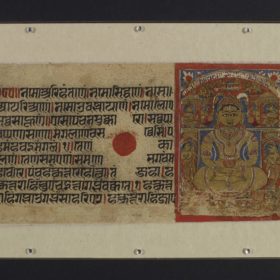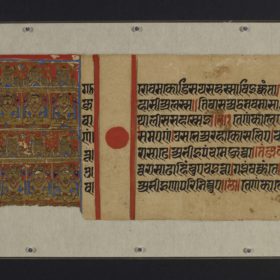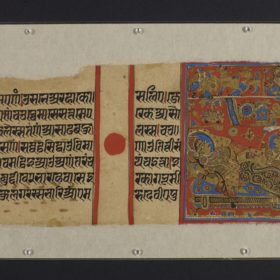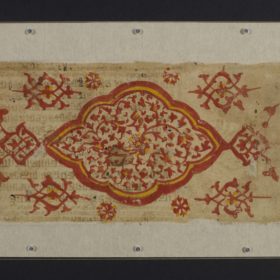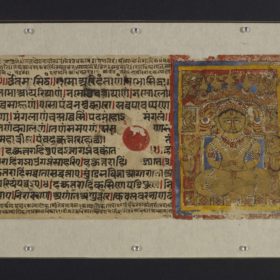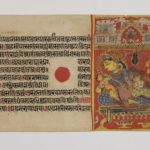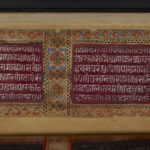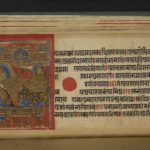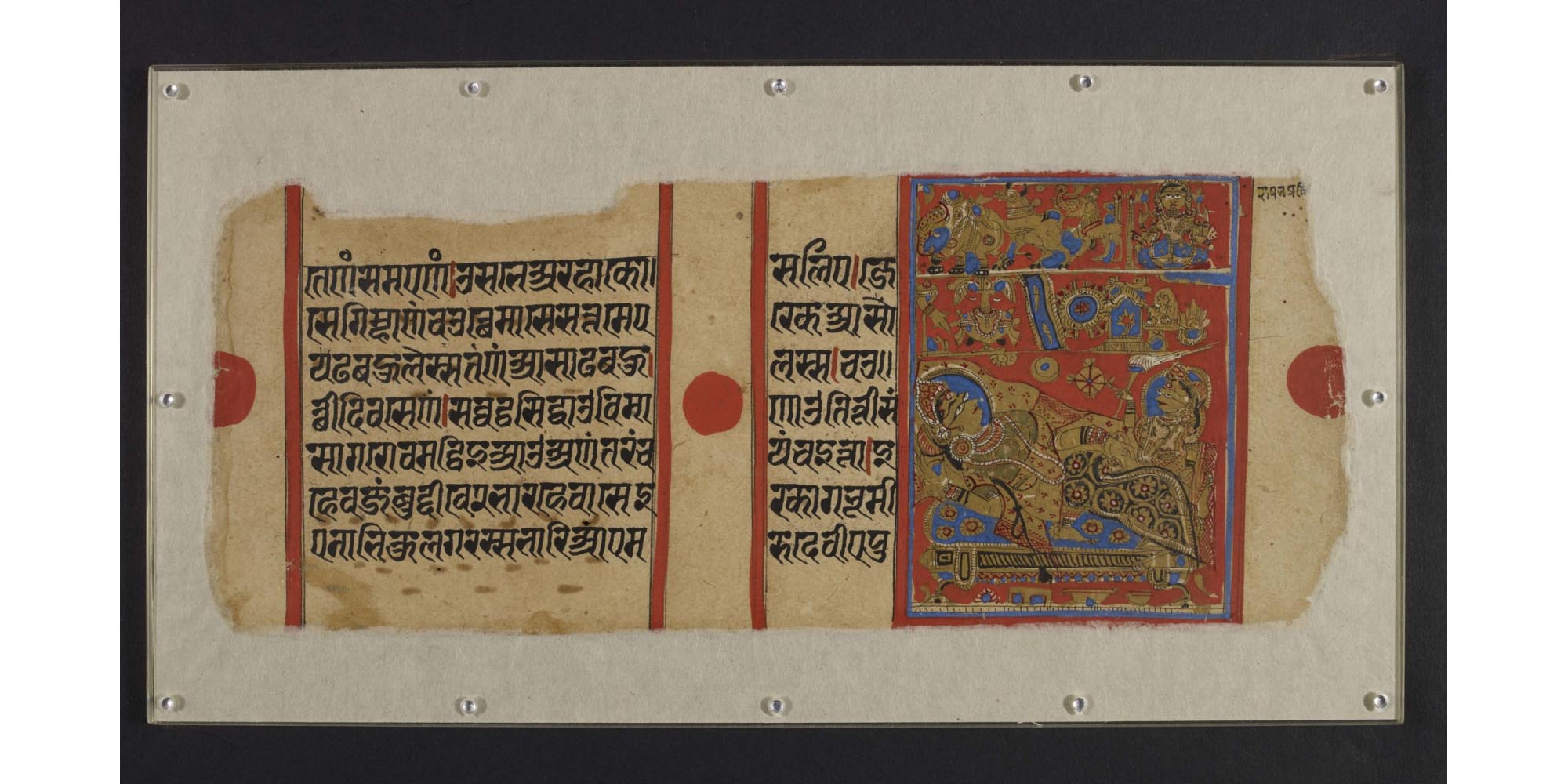
Background
The Kalpa-sūtra is the most frequently illustrated Jain text of the Śvetāmbara sect. It is read and recited by monks in the festival of Paryuṣaṇ, which takes place in August to September each year.
The first part of the Kalpa-sūtra deals with the lives of the Jinas, especially Mahāvīra, Pārśva, Nemi and Ṛṣabha. It features almost identical stories of their births, lives as princes and then their renunciation, enlightenment and emancipation.
The second part – Sthavirāvali – is a praise of the early teachers of Jainism. The third part – Sāmācārī – deals with particular monastic rules to be followed during the rainy season.
Assorted folios
The pages or folios under this shelfmark belong to different manuscripts. The folios show a variety of handwriting, language and artistic style and are on noticeably different paper.
The folios are from four separate manuscripts, as follows:
- several folios are from a single manuscript of the Kālakācārya-kathā – Story of the Ācārya Kālaka
- three folios are from different manuscripts of the Kalpa-sūtra, an extremely popular text in the Śvetāmbara canon.
There is also a manuscript holder made for an unknown manuscript.
It is not known what has happened to the rest of each manuscript.
Copies of the Kalpa-sūtra and Kālakācārya-kathā are often made in a single manuscript, which may be why these folios were bundled together. At some point in the past these folios and the manuscript holder were put into a box at the British Library and labelled ‘Frags. of Jain Mss. Skt. / Pkt.’ meaning 'Fragments of Jain manuscripts in Sanskrit and Prakrit'. However, it is important to remember that they do not belong together.
Transcription
1. teṇaṃ samaeṇaṃ / Usabhe arahā Kosalie / je
2. se gimhāṇaṃ cautthe māse sattame pakkhe Āsā-
3. yaḍha-bahule ssa taṃ [should be tassa] ṇaṃ Āsāḍha-bahulassa / cau-
4. tthī-divaseṇaṃ / Savvaṭṭhasiddhāo vimāṇāo tittīsaṃ
5. sāgarovama-ṭṭhiiāo aṇaṃtaraṃ cayaṃ caittā / i-
6. h’ eva Jambuddīve 2 Bhārahe-vāse Ikkhāga-bhūmī-
7. e Nābhi-kulakgarassa bhāriāe Marudevīe pu-
Translation
1. at that time the Arhat Ṛṣabha from Kosala
2. in the fourth month of summer, in the seventh fortnight
3. in the dark fortnight of Āsāḍha, on the fourth day
4. of the dark fortnight of Āsāḍha, he descended from the heaven Sarvārthasiddha
5. after he had stayed there for 33 sāgaropamas,
6. here, in the continent Jambū-dvīpa, in the land Bhārata, on the territory of the Ikṣvāku
7. [he took form in the womb] of Marudevī, the wife of the patriarch Nābhi.
Glossary
Description
The caption in the top right corner reads: Ṛṣabhaprati[mā] – 'image of Ṛṣabha'.
A lady lying on a bed is being fanned by a servant, who stands on the right side. Above her are two rows of animals, figures and objects.
The richly jewelled lady is Queen Mārudevī, mother of the first Jina, Ṛṣabhanātha or Lord Ṛṣabha. This identification is only possible thanks to the facing text, which relates to Ṛṣabha and mentions his name and those of his parents. The scene in itself has no individual characteristics and is identical to the birth scene for all Jinas, for example the birth of the 22nd Jina Nemi and the birth of the 24th Jina Mahāvīra.
The queen is full of joy about her new pregnancy. Like the mother of all Jinas, she has 14 dreams that announce the greatness of the future baby, who will become Ṛṣabha. The symbols of these dreams are depicted in the levels above Mārudevī.
Starting from the top left and moving left to right, the sequence of the dreams is divided into two levels. On the top row the dreams are depicted as:
- an elephant
- a bull
- a lion
- a garland
- the goddess Śrī.
On the second row the dreams are represented by:
- a banner
- a vase full of water
- an ocean of milk
- a lotus lake
- a celestial palace
- a heap of jewels
- a fire.
Below, between the queen and her attendant, are two circles representing:
- the sun
- the moon.
These two are shown smaller because the painter is using the space practically, but all dreams have the same importance. The order of the 14 auspicious dreams is always the same in the text of the Kalpa-sūtra, but the manuscript painters can choose how to use the space at their disposal.
Other visual elements
As with many Kalpa-sūtra manuscripts, there is a clear intention to make the manuscript a valuable and remarkable object in itself. This aim is signalled by the:
- shape and style of the script, which is close to calligraphy
- use of gold ink in the paintings
- division of the text into two equally-sized panels, separated by a 2-centimetre margin containing a red circle.
The three red circles along the central horizontal plane are symbolic reminders of the way in which palm-leaf manuscripts were bound at one time. Strings through these holes in the palm leaf were used to thread together the loose folios so the reader could turn them over easily. The circles are in the place where the hole would once have been. Three circles mean a verso side.
The folio number, which should have been visible in the lower right corner of this verso side, is not visible as the edges are damaged.
Script
The elaborate script used is the Jaina Devanāgarī, which is like calligraphy. It is used for writing numerous Indian languages, here for Prakrit.
There are a few notable features of this script, which:
- is an old type in the way the sounds e and o are notated when used with a consonant, known as pṛṣṭhamātrā script
- uses red ink for various purposes.
Red is used to highlight stanza breaks and certain symbols and phrases, specifically:
- the vertical lines within the text marking verse divisions, with single red vertical lines indicating where a verse is divided in two while double red vertical lines are found at the end of the verse
- for the symbol cha, seen in the middle of line 3 and in the last line, which signals the end of a section or paragraph
- for the phrase on line 5 taṃ jahā – ‘to wit’ – which introduces a list.
- Source:
The British Library Board
- Shelfmark:
Or. 13950
- Author:
unknown
- Date of creation:
unknown
- Folio number:
verso
- Total number of folios:
10
- Place of creation:
western India
- Language:
various in Devanāgarī script
- Medium:
opaque watercolour on paper
- Size:
25 x 10.5 cms
- Copyright:
CC0 1.0 (Creative Commons Public Domain)
- Image Copyright:
- +
- aAbhavya
- aAbhinandana
- aAbhiṣeka
- aĀcāra
- aĀcārāṅga-sūtra
- aĀcārya
- aAchalbhrata
- aAḍhāī-dvīpa
- aAdharma
- aAdho-loka
- aAdhyayana
- aAdvaita Vedānta
- aĀgama
- aAghātīya
- aAghātīya-karman
- aAgnibhuti
- aAgra
- aĀhāra
- aAhiṃsā
- aAhimsa Day
- aAjita
- aAjīva
- aAkampit
- aĀkāśa
- aAkbar the Great
- aAkṣaya-tṛtīyā
- aAlauddin Khalji
- aAlbert Einstein
- aAllah
- aAlms
- aĀlocanā
- aAloka-ākāśa
- aAmāri
- aAmbikā or Kūṣmāṇḍinī
- aAnagāra
- aAnanta
- aAnarthadaṇḍa
- aAnaśana
- aAnekānta-vāda
- aAṅga
- aAniconism
- aAnojjā
- aAntarāla
- aAntarāya-karma
- aAṇu
- aAṇu-vrata
- aAnukampā
- aAnuprekṣā
- aAnusvāra
- aApabhraṃśa
- aAparigraha
- aAra
- aĀrambha
- aĀrambhaja
- aĀratī
- aArdhamāgadhī Prākrit
- aArhaṃ
- aArhat
- aArśana-āvaraṇīya-karma
- aĀrta-dhyāna
- aĀryikā
- aĀryikā Jñānamati
- aĀśātanā
- aĀścarya
- aAscetic
- aAsceticism
- aAshram
- aAspiration
- aĀsrava
- aAṣṭa-maṅgala
- aAṣṭāpada
- aAstikāya
- aAstrolabe
- aAsura
- aAtheism
- aAticāra
- aAtiśayakṣetra
- aAtithisaṃvibhāgavrata
- aĀtma-vāda
- aĀtman
- aAuṃ
- aAurangzeb
- aAuspicious
- aAusterity
- aAvadhāna
- aAvadhi-jñāna
- aĀvaraṇī-yakarman
- aAvasarpiṇī
- aAvatāra
- aAvidyā
- aAxiom
- aĀyāga-paṭa
- aĀyambil
- aĀyu-karma
- aĀyurveda
- bBabur
- bBāhubali
- bBaladeva
- bBālāvabodha
- bBandha
- bBasadi
- bBazaar
- bBhadrankarvijay
- bBhagavant
- bBhaktāmara-stotra
- bBhakti
- bBhale
- bBharata
- bBhāṣā
- bBhāṣya
- bBhaṭṭāraka
- bBhāva
- bBhāva-pūjā
- bBhāvanā
- bBhavana-vāsin
- bBhavya
- bBhavyatva
- bBhaya
- bBhoga-bhūmi
- bBhogopabhoga
- bBodhi
- bBollywood
- bBrahmā
- bBrahma-deva
- bBrahmacārī
- bBrāhmaṇa
- bBraj Bhāṣā
- bBright fortnight
- bBritish Raj
- bBuddha
- bBuddhi-sagar
- bBuddhism
- bBuddhist
- cCaitya
- cCaityavāsin
- cCakravartin
- cCakreśvarī
- cCāmara
- cCandanā
- cCandragupta
- cCandraprabha
- cCanon
- cCāritra
- cCāritramohanīya-karman
- cCarũrī
- cCaste
- cCaturvidha-saṅgha
- cCaturviṃśati-stava
- cCāturyāma
- cCE
- cCelibacy
- cCha
- cChadmastha
- cChastity
- cCheda-sūtra
- cChristian
- cChristianity
- cClergy
- cCloning
- cColophon
- cCommentary
- cConch
- cConfession
- cCongregation
- cConsecration
- cCosmology
- cCremation
- cCrore
- cCult
- cCūrṇi
- dDādā-guru
- dDalit
- dDāna
- dDaṇḍa
- dDark fortnight
- dDarśana
- dDarśanamohanī-yakarman
- dDaśa-lakṣaṇa-parvan
- dDeity
- dDelhi Sultanate
- dDerāsar
- dDeśāvakāśika-vrata
- dDetachment
- dDevanāgarī
- dDevānandā
- dDevarddhi-gani
- dDevotee
- dDhamal
- dDhanuṣ
- dDhāra
- dDharma
- dDharma-dhyāna
- dDharma-sāgara
- dDharmastikaya
- dDhātakīkhaṇḍa
- dDholak
- dDhyāna
- dDiaspora
- dDig-vrata
- dDigambara
- dDīkṣā
- dDisciple
- dDīvālī
- dDivya-dhvani
- dDNA
- dDoctrine
- dDogma
- dDonor
- dDoṣa
- dDravya
- dDravya-pūjā
- dDrone
- dDuṣamā
- dDuṣamā-duṣamā
- dDuṣamā-suṣamā
- dDveṣa
- dDvīpa
- eEast India Company
- eEightfold Path
- eEkānta-vāda
- eEkendriya
- eElder
- eElders
- eEschatology
- eEtc up to
- fFarmān
- fFast
- fFatehpur Sikri
- fFestival
- fFestschrift
- fFiruz Shah
- fFly-Whisks
- fFolio
- fFour Noble Truths
- gGaccha
- gGaṇa
- gGaṇadhara
- gGanadharavada
- gGaṇeśa
- gGaṇin
- gGarba
- gGarbha
- gGarbha-gṛha
- gGaruḍa
- gGati
- gGene
- gGenomics
- gGhātī-yakarman
- gGhātīya
- gGhaznavid
- gGhiyasuddin Tughlaq
- gGhurid
- gGloss
- gGotra-karma
- gGujarāt
- gGujarati
- gGuṇa
- gGuṇa-sthāna
- gGuṇa-vrata
- gGupti
- gGuru
- gGuruṇī
- hHagiography
- hHajj
- hHaṃsa
- hHaribhadra
- hHariṇaigameṣin
- hHasta
- hHeresy
- hHiṃsā
- hHindi
- hHindu
- hHinduism
- hHīravijaya
- hHoroscope
- hHrīṃ
- hHumayun
- hHymn
- iIconoclasm
- iIconography
- iIdol
- iIndian Independence
- iIndology
- iIndra
- iIndrabhūti Gautama
- iIndriya
- iInitiation
- iIntercession
- iInvocation
- iIQ
- iIslam
- iIslamicate
- iIṣṭadevatā
- iĪśvara
- jJagat
- jJahangir
- jJain
- jJaina Devanāgarī
- jJaina Śaurasenī
- jJaina-dharma
- jJainaśāsana
- jJainness
- jJaisalmer
- jJamāli
- jJambū-dvīpa
- jJames Burgess
- jJanma
- jJanma-kalyāṇa
- jJarā
- jJāti
- jJina
- jJina-āgama
- jJina-bhavana
- jJina-bimba
- jJina-mātā
- jJinacandra-sūri
- jJinadatta
- jJinaprabha
- jJīva
- jJñāna
- jJñāna-āvaraṇīya-karma
- jJñāna-āvarṇiya
- jJñānsundar
- jJyotiṣka
- kKāla
- kKālakācārya-kathā
- kKālidāsa
- kKalpa-sūtra
- kKalpa-vṛkṣa
- kKalyāṇaka
- kKalyanvijay
- kKamaṇḍalu
- kKamaṭha
- kKarma
- kKarma-bhūmi
- kKarma-grantha
- kKarma-prakṛti
- kKarma-vāda
- kKarmon
- kKarnataka
- kKaṣāya
- kKathā
- kKāvya
- kKāya
- kKāyotsarga
- kKeśa-loca
- kKetu
- kKevala-jñāna
- kKevalin
- kKhalji
- kKharatara-gaccha
- kKnowledge
- kKriyā
- kKriyā-vāda
- kKṛṣṇa
- kKṣamā-śramaṇa
- kKṣapakaśreṇi
- kKṣatriya
- kKṣullaka
- kKulakara
- kKundakunda
- kKunthu
- lLabdhi
- lLaity
- lLakh
- lLāñchana
- lLands of Action
- lLaukāntika
- lLavaṇa-samudra
- lLeśyā
- lLiṅga
- lLinguistics
- lLoka
- lLoka-ākāśa
- lLoka-puruṣa
- lLoka-vāda
- lLotus
- lLotus lake
- mMadhya-loka
- mMahā-videha
- mMahā-vrata
- mMahābhārata
- mMahāmastakābhiṣeka
- mMāhārāṣṭra
- mMāhārāṣṭrī Prākrit
- mMahattarā Yākinī
- mMahāvīr Jayantī
- mMahāvīra
- mMakāra
- mMakkhali Gośāla
- mMalli
- mMāna-stambha
- mManaḥ-paryāya-jñāna
- mMaṇḍala
- mMaṇḍapa
- mMandit
- mMaṅgala
- mMantra
- mMantras
- mManuṣya-loka
- mMarāṭhī
- mMārgaṇā
- mMartyr
- mMarudevī
- mMaṭha
- mMati-jñāna
- mMauryaputra
- mMecca
- mMendicant lineage
- mMetarya
- mMiracle
- mMithyādṛṣṭi
- mMohandas Gandhi
- mMohanīya-karma
- mMokṣa
- mMonastic order
- mMonasticism
- mMonk
- mMonotheism
- mMosque
- mMount Meru
- mMount Sammeta
- mMṛgāvatī
- mMughal
- mMuhammad
- mMuhammad bin Tughlaq
- mMuhpattī
- mMūla-sūtra
- mMūlaguṇa
- mMumbaī
- mMuni
- mMunisuvrata
- mMurad Bakhsh
- mMūrti-pūjaka
- mMuslim
- mMysticism
- nNābhi
- nNāga-kal
- nNāgapurīya Tapā-gaccha
- nNāgarī
- nNāma-karma
- nNamaskāra-mantra
- nNami
- nNandīśvara-dvīpa
- nNandivardhana
- nNandyāvarta
- nNāraka
- nNāraki
- nNasalisation
- nNātha
- nNavrātrī
- nNaya-vāda
- nNemi
- nNidāna
- nniggaṃthāṇa vā 2
- nniggaṃtho vā 2
- nNigoda
- nNihnava
- nNikṣepa
- nNirgrantha
- nNirjarā
- nNirvāṇa
- nNiryukti
- nNiṣidhi
- nNitya
- nNiyati
- nNo-kaṣāya
- nNudity
- nNun
- oOcean of milk
- oOmniscience
- oOrdination
- ppa°
- pPadmaprabha
- pPadmāsana
- pPadmāvatī
- pPādukā
- pPalanquin
- pPalette
- pPañca-muṣṭi
- pPāṇḍava
- pPaṇḍit
- pPandit Dalsukh D. Malvania
- pPandit Sukhlalji
- pPāṇipātra
- pPāpa
- pParamātman
- pParameṣṭhin
- pPāraṇā
- pParigraha
- pPariṇāma
- pParīṣaha
- pParokṣa
- pPārśva
- pPārśvanātha
- pParyāya
- pParyuṣaṇ
- pPaṭa
- pPatan
- pPātra
- pPenance
- pPersian
- pPhala
- pPhilology
- pPicchikā
- pPilgrimage
- pPīr
- pPolymath
- pPoṣadha
- pPossession
- pPothī
- pPrabhas
- pPradakṣiṇā
- pPradeśa
- pPrākāra
- pPrakīrṇaka-sūtra
- pPrākrit
- pPramāda
- pPramukhā
- pPrati-vāsudeva
- pPratikramaṇa
- pPratimā
- pPratiṣṭhā
- pPratyākhyāna
- pPratyakṣa
- pPravacana
- pPrāyaścitta
- pPrayer
- pPre-modern
- pPreach
- pPredestination
- pProtestant
- pProvenance
- pPudgala
- pPūjā
- pPujārī
- pPukharavara-dvīpa
- pPuṇya
- pPūrva
- pPuṣkara-dvīpa
- pPuṣpadanta
- pPyre
- qQur’an
- rRāga
- rRāhu
- rRainy season
- rRajasthan
- rRajasthani
- rRājimatī
- rRajoharaṇa
- rRajput
- rRāma
- rRāmāyaṇa
- rRangoli
- rRās-garbā
- rRasa
- rRathanemi
- rRatna-traya
- rRātri-bhojana
- rRaudra-dhyāna
- rRecto
- rRelic
- rRenunciation
- rRetroflex
- rRevatī
- %Ṛg-veda
- rRite
- rRosary
- %Ṛṣabha
- %Ṛṣabhanātha
- rRupee
- sSaciyā Mātā
- sSādhu
- sSādhvī
- sSāgāra
- sSaint
- sŚaivaism
- sŚaka-saṃvat
- sSallekhanā
- sŚalya
- sSamacatuṣṭha
- sSamādhimaraṇa
- sSamaṇi
- sSāmarambha
- sSamavasaraṇa
- sSāmāyika
- sSaṃbhava
- sSamiti
- sSaṃjñā
- sSaṃkalpaja
- sSaṃsāra
- sSamudghāta
- sSaṃvara
- sSaṃvega
- sSamyak-cāritra
- sSamyak-darśana
- sSamyak-jñāna
- sSamyaktva
- sSaṃyama
- sSanctuary
- sSandalwood
- sSaṇgha
- sSanskrit
- sSant
- sŚānti
- sSapta-bhaṅgi-naya
- sSārambha
- sSarasvatī
- sSarvajña
- sSāsan-devi
- sŚāsana-devatā
- sŚāstra
- %Ṣaṭ-jīvanikāya
- sSatī
- sSatīmātā
- sSatya
- sSchism
- sScribe
- sScripture
- sSect
- sSecularism
- sŚenāī
- sSermon
- sŚeṣavatī
- sSevā
- sSeven fields of donation
- sShah Jahan
- sShantidas Jhaveri
- sShrine
- sSiddha
- sSiddha-śilā
- sSiddhacakra or Navadevatā
- sSiddhānta
- sSiddhārtha
- sSiddhi
- sSikh
- sSikhism
- sŚikṣā-vrata
- sŚīla
- sSin
- sSindh
- sŚītala
- sŚiva
- sSkandha
- sSomanatha
- sŚraddhā
- sŚramaṇa
- sŚrāvaka
- sŚrāvakācāra
- sŚrāvikā
- sŚreyāṃsa
- sŚrī
- sŚrīvatsa
- sŚruta-jñāna
- sŚruta-pañcamī
- sSthānaka-vāsin
- sSthāpanācārya
- sSthāvara
- sSthavira
- sSthiti
- sStrīmukti
- sStūpa
- sSubcontinent
- sSudarshana
- sŚuddhi
- sSudharma
- sŚūdra
- sSufism
- sSukha
- sŚukla-dhyāna
- sSulasā
- sSultan
- sSumati
- sSundarśrī
- sSupārśva
- sSūri
- sSuṣamā
- sSuṣamā-duṣamā
- sSuṣamā-suṣamā
- sSūtra
- sSuyam me ausam! Tenam bhagavaya evamakkhayam
- sSvādhyāya
- sSvāhā
- sSvastika
- sŚvetāmbara
- sŚvetāmbara Terāpanthin
- sŚvetāmbaras
- sSwan
- sSyād-vāda
- tTabla
- tTantra
- tTapā-gaccha
- tTapas
- tTāraṇ Svāmī Panth
- tTattva
- tTattvārtha-sūtra
- tTemple
- tTemple-city
- tThe Enlightenment
- tTheology
- tThree worlds
- %Ṭīkā
- tTilaka
- tTīrtha
- tTīrthaṃkaranāma-karman
- tTīrthankara
- tTransliteration
- tTrasa
- tTrasa-nāḍī
- tTriśalā
- tTriṣaṣṭi-śalākā-puruṣa-caritra
- tTti bemi
- tTughlaq
- tTunk
- uUdumbara
- uUniversal History
- uUpādhyāya
- uUpāṅga
- uUpaniṣads
- uUpāsaka
- uUpasarga
- uUpāśraya
- uŪrdhva-loka
- uUtsarpiṇī
- uUttarādhyayana-sūtra
- vVāhana
- vVaimānika
- vVairāgya
- vVaiṣṇava
- vVaiśramaṇa
- vVaiśya
- vValabhī
- vVanaspatikāya
- vVandana
- vVaṇik
- vVarṇa
- vVāsudeva
- vVāsupūjya
- vVayubhūti
- vVeda
- vVedanīya-karma
- vVegetarianism
- vVehicle
- vVernacular
- vVerso
- vVidyā
- vVidyā-devī
- vVihāra
- vVijñapti-patra
- vVikrama-saṃvat
- vVikṛti
- vVimala
- vVinaya
- vVipāka
- vVirji Vora
- vVirodhaja
- vVīrya
- vVisarga
- vViṣṇu
- vVītarāga
- vVizier
- vVotive
- vVow
- vVrata
- vVS
- vVyakta
- vVyantara
- vVyasana
- yYakṣa
- yYakṣī
- yYantra
- yYaśoda
- yYaśovijaya
- yYati
- yYātrā
- yYoga
- yYoginī
- yYojana
Description
The caption in the top right corner reads: Ṛṣabhaprati[mā] – ‘image of Ṛṣabha’.
A lady lying on a bed is being fanned by a servant, who stands on the right side. Above her are two rows of animals, figures and objects.
The richly jewelled lady is Queen Mārudevī, mother of the first Jina, Ṛṣabhanātha or Lord Ṛṣabha. This identification is only possible thanks to the facing text, which relates to Ṛṣabha and mentions his name and those of his parents. The scene in itself has no individual characteristics and is identical to the birth scene for all Jinas, for example the birth of the 22nd Jina Nemi and the birth of the 24th Jina Mahāvīra.
The queen is full of joy about her new pregnancy. Like the mother of all Jinas, she has 14 dreams that announce the greatness of the future baby, who will become Ṛṣabha. The symbols of these dreams are depicted in the levels above Mārudevī.
Starting from the top left and moving left to right, the sequence of the dreams is divided into two levels. On the top row the dreams are depicted as:
On the second row the dreams are represented by:
- a banner
- a vase full of water
- an ocean of milk
- a lotus lake
- a celestial palace
- a heap of jewels
- a fire.
Below, between the queen and her attendant, are two circles representing:
- the sun
- the moon.
These two are shown smaller because the painter is using the space practically, but all dreams have the same importance. The order of the 14 auspicious dreams is always the same in the text of the Kalpa-sūtra, but the manuscript painters can choose how to use the space at their disposal.
Other visual elements
As with many Kalpa-sūtra manuscripts, there is a clear intention to make the manuscript a valuable and remarkable object in itself. This aim is signalled by the:
- shape and style of the script, which is close to calligraphy
- use of gold ink in the paintings
- division of the text into two equally-sized panels, separated by a 2-centimetre margin containing a red circle.
The three red circles along the central horizontal plane are symbolic reminders of the way in which palm-leaf manuscripts were bound at one time. Strings through these holes in the palm leaf were used to thread together the loose folios so the reader could turn them over easily. The circles are in the place where the hole would once have been. Three circles mean a verso side.
The folio number, which should have been visible in the lower right corner of this verso side, is not visible as the edges are damaged.
Script
The elaborate script used is the Jaina Devanāgarī, which is like calligraphy. It is used for writing numerous Indian languages, here for Prakrit.
There are a few notable features of this script, which:
- is an old type in the way the sounds e and o are notated when used with a consonant, known as pṛṣṭhamātrā script
- uses red ink for various purposes.
Red is used to highlight stanza breaks and certain symbols and phrases, specifically:
- the vertical lines within the text marking verse divisions, with single red vertical lines indicating where a verse is divided in two while double red vertical lines are found at the end of the verse
- for the symbol cha, seen in the middle of line 3 and in the last line, which signals the end of a section or paragraph
- for the phrase on line 5 taṃ jahā – ‘to wit’ – which introduces a list.





























































































